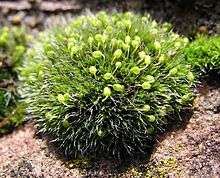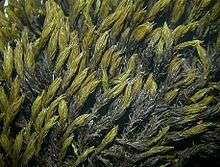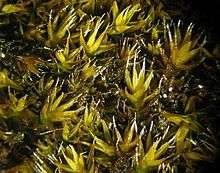Grimmia
| Grimmia | |
|---|---|
 | |
| Grimmia pulvinata | |
| Scientific classification | |
| Kingdom: | Plantae |
| Division: | Bryophyta |
| Class: | Bryopsida |
| Subclass: | Bryidae |
| Order: | Grimmiales |
| Family: | Grimmiaceae |
| Genus: | Grimmia Hedw. |



Grimmia is a genus of mosses (Bryophyta), originally named by Jakob Friedrich Ehrhart in honour of Johann Friedrich Carl Grimm, a physician and botanist from Gotha, Germany.
Geographic distribution
Although predominantly occurring in the moderate zones, representatives of the cosmopolitan genus Grimmia may be found in all parts of the world, from Alaska to the most southern point of Chile, and from Siberia to South Africa, though in tropic regions, e.g. Hawaii and Indonesia, Grimmia species only occur high up in the mountains.
Identification
Grimmia is a notoriously difficult genus in terms of identification, and in the majority of herbaria a considerable number of species was found misidentified. The American bryologist Geneva Sayre[1] (1911–1992), who worked for many years on a monograph of the North American Grimmias, indicated in an original way these difficulties, as she said: "it contains an ambigua, a varia, a decipiens, a controversa, a revisa and at least two anomalas".[2]
Publications
In the Index Muscorum,[3] the genus Grimmia is represented with 800 names of published species. As since Loeske (1930),[4] no revision of the European species had been carried out.
The Dutch bryologist H. C. Greven started in 1990 with Grimmia fieldwork and a revision of the Grimmia collections from important European herbaria. The results were published in "Grimmia Hedw. (Grimmiaceae, Musci) in Europe".[5]
After examining the Grimmia collections from herbaria in North- and South America, South Africa, Australia and New Zealand, and about 50 Grimmia collecting trips in all continents, Grimmias of the World was published.[6] An important contribution was the revision of Grimmia in North America.[7]
In the past decades, some more bryologists became interested in the genus Grimmia. Jesús Muñoz published a herbaria revision of Grimmia in Latin America,[8] and Maier studied herbarium specimens of Grimmia from the Himalaya.[9]
Latest discovered species
In the past 15 years (1996 to 2010), the following Grimmia species have been discovered and described:
- Grimmia maido (Greven 1996)[10]
- Grimmia macroperichaetialis (Greven 1998)[11]
- Grimmia ochyriana (Muñoz 1998)[12]
- Grimmia wilsonii (Greven 1998)[13]
- Grimmia mexicana (Greven 1999)[14]
- Grimmia molesta (Muñoz 1999)[8]
- Grimmia indica (Goffinet & Greven 2000)[15]
- Grimmia dissimulata (Maier 2002b)[16]
- Grimmia nevadensis (Greven 2002)[17]
- Grimmia serrana (Muñoz, Shevock & Toren 2002)[18]
- Grimmia lesherae (Greven 2003)[6]
- Grimmia mauiensis (Greven 2003)[6]
- Grimmia maunakeaensis (Greven 2003)[6]
- Grimmia shastae (Greven 2003)[6]
- Grimmia milleri (Hastings & Greven 2007)[7]
- Grimmia torenii (Hastings 2008)[19]
- Grimmia texicana (Greven 2010)[20]
References
- ↑ Farlow Reference Library at Harvard University
- ↑ Richards, P. (1993). "Geneva Sayre (1911-1992)". Journal of Bryology. 17: 696–698.
- ↑ Wijk, van der, R.; W. G. Margadant; P. A. Florschütz (1962). Index Muscorum. Utrecht, Netherlands: International Association for Plant Taxonomy.
- ↑ Loeske, L. (1930). Monographie der europäischen Grimmiaceen. Stuttgart, Germany: E. Schweizerbart'sche Verlagsbuchhandlung.
- ↑ Greven, H. C. (1995). Grimmia Hedw. (Grimmiaceae, Musci) in Europe. Leiden, Netherlands: Backhuys Publishers. p. 160. ISBN 90-73348-38-2.
- 1 2 3 4 5 Greven, H. C. (2003). Grimmias of the World. Leiden, Netherlands: Backhuys Publishers. p. 247. ISBN 90-5782-127-3.
- 1 2 Hastings, R. I.; H. C. Greven (2007). "Grimmia milleri sp. nov. (Grimmiaceae) from northeastern North America and the status of Grimmia afroincurva". The Bryologist. 110 (3): 500–505. doi:10.1639/0007-2745(2007)110[500:gmsngf]2.0.co;2. JSTOR 20110882.
- 1 2 Muñoz, J. (1999). "A revision of Grimmia (Musci, Grimmiaceae) in the Americas. 1: Latin America". Annals of the Missouri Botanical Garden. 86 (1): 118–191. JSTOR 2666219.
- ↑ Maier, E. (2002). "The genus Grimmia (Musci, Grimmiaceae) in the Himalaya". Candollea. 57: 143–238.
- ↑ Greven, H. C. (1996). "Grimmia maido and Grimmia sanii, Two new species from Africa". The Bryologist. 99 (4): 428–432. JSTOR 3244106.
- ↑ Greven, H. C. (1998). "Grimmia macroperichaetialis, a new species from Australia". The Bryologist. 101: 100–102. doi:10.2307/3244079.
- ↑ Muñoz, J. (1998). "Grimmia ochyriana (Musci, Grimmiaceae), a new species from Nepalese Himalaya". Nova Hedwigia. 66: 235–240.
- ↑ Greven, H. C. (1998). "Synopsis of Grimmia Hedw. in New Zealand, including Grimmia wilsonii sp. nov.". Journal of Bryology. 20: 389–402. doi:10.1179/jbr.1998.20.2.389.
- ↑ Greven, H. C. (1999). "A synopsis of Grimmia in Mexico, including Grimmia mexicana sp. nov.". The Bryologist. 102 (3): 426–436. JSTOR 3244231.
- ↑ Goffinet, B.; H. C. Greven (2000). "Grimmia indica (Grimmiaceae), a new combination". Journal of Bryology. 22: 141.
- ↑ Maier, E. (2002). "Grimmia dissimulata E. Maier sp. nova, and the taxonomic position of Grimmia trichophylla var. meridionalis Müll. Hal. (Musci, Grimmiaceae)". Candollea. 56: 281–300.
- ↑ Greven, H. C. (1999). "Grimmia nevadensis, a new species from California". The Bryologist. 105 (2): 273–275.
- ↑ Muñoz, J.; J. R. Shevock; D. Toren (2002). "Grimmia serrana (Bryopsida, Grimmiaceae), a new species from California, U.S.A." (PDF). Journal of Bryology. 24: 143–146. doi:10.1179/037366802125001006.
- ↑ Hastings, R. I. (2008). "Grimmia torenii sp. nov. (Grimmiaceae) from California and its separation from G. ovalis and G. tergestina". The Bryologist. 111 (3): 463–475. doi:10.1639/0007-2745(2008)111[463:GTSNGF]2.0.CO;2.
- ↑ Greven, H. C. (2010). "Grimmia texicana sp. nov. (Grimmiaceae) from Texas and its separation from Grimmia arizonae". The Bryologist. 113 (2). doi:10.1639/0007-2745-113.2.360.
External links
- Grimmias of the World Online reference guide, including more than 2000 macro- and microscopic photos of all 96 recognised Grimmia species. Additionally, the website includes a Worldchecklist, table of World distribution, European checklist and major ecological and morphological characters of the Grimmia species.
